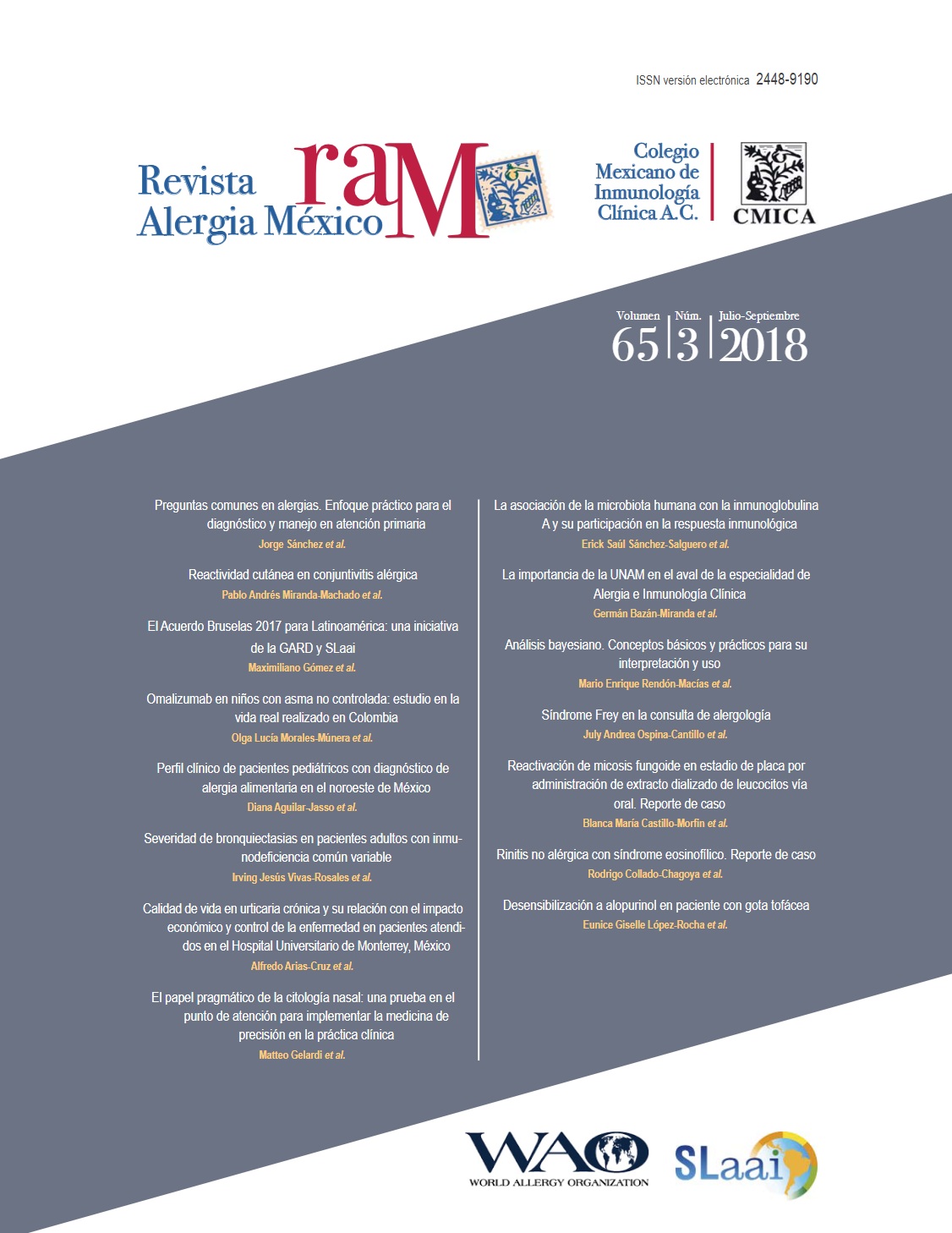Abstract
Background: Allopurinol is a xanthine oxidase inhibitor used in the treatment of patients with gout. Approximately 2% of patients are affected by adverse reactions to this drug. Severity ranges from mild rashes to severe reactions in up to 0.4% of cases. De-sensitization is carried out by administering increasing doses of the drug.
Case report: Thirty-year old man diagnosed with hypercholesterolemia and hypertriglyceridemia treated with bezafibrate and pravastatin, systemic arterial hypertension treated with losartan and a 10-year history of hyperuricemia with gout. Tophi were found in metacarpophalangeal joints and elbows. Treatment was started with allopurinol 300 mg/day. Two weeks later, he experienced facial erythema with itching and maculopapular lesions on the malar region 1 hour after the medication was ingested. An outpatient drug de-sensitization protocol was initiated, starting with 5 mg, and with gradual dose increases every 4 to 5 days for 59 days until the desired maintenance dose (300 mg) was reached.
Conclusions: Experience shows that de-sensitization to allopurinol is a safe alternative when there is hypersensitivity and treatment with this drug is required.
References
Tanna SB, Barnes JF, Seth SK. Desensitization to allopurinol in a patient with previous failed desensitization. Ann Pharmacother. 1999;33(11):1180-1183. DOI: 10.1345/aph.19043
Mclnnes GT, Lawson DH, Jick H. Acute adverse reactions attributed to allopurinol in hospitalized patients. Ann Rheum Dis. 1981;40(3):245-249.
Fam AG. Difficult gout and new approaches for control of hyperuricemia in the allopurinol-allergic patient. Curr Rheumatol Rep. 2001;3(1):29-35.
Calogiuri G, Netis E, Di-Leo E, Foti C, Ferrannini A, Butani L. Allopurinol hypersensitivity reactions: desensitization strategies and new therapeutic alternative molecules. Inflamm Allergy Drug Targets. 2013;12(1):19-28. DOI: 0.2174/1871528111312010004
Fam AG, Dunne SM, Iazzetta J, Paton TW. Efficacy and safety of desensitization to allopurinol following cutaneous reactions. Arthitis Rheum. 2001;44(1):231-238. DOI: 10.1002/1529-0131(200101)44:1<231::AID-ANR30>3.0.CO;2-7
Domínguez-Ortega J, Trindade C, Alonso-Llamazares A, Castellano-Bravo A, Cimarra-Álvarez-Lovell M, Martínez-Cócera C. Hipersensibilidad al alopurinol: Eficacia de un protocolo de desensibilización en tres casos. An Med Interna. 2001;18(1):27-28.
Toker O, Tvito A, Rowe JM, Ashkenazi J, Ganzel C, Tal Y, et al. Rapid oral allopurinol desensitization in a patient with chronic myeloid leukemia. Isr Med Assoc J. 2014;16(7):461-462.
Oka T, Rios EJ, Tsai M, Kalesnikoff J, Galli SJ. Rapid desensitization induces internalization of antigen-specific IgE on mouse mast cells. J Allergy Clin Immunol. 2013;132(4):922-932. DOI: 10.1016/j.jaci.2013.05.004
Soares J, Caiado J, Lopes A, Pereira M. Allopurinol desensitization: a fast or slow protocol? J Investig Allergol Clin Immunol. 2015;25(4):295-315.
Calogiuri G, Nettis E, Di Leo E, Foti C, Ferrannini A, Butani L. Allopurinol hypersensitivity reactions: desensitization strategies and new therapeutic alternative molecules. Inflamm Allergy Drug Targets. 2013;12(1):19-28. DOI: 10.2174/1871528111312010004
Meyrier A. Desensitization in a patient with chronic renal disease and severe allergy to allopurinol. Br Med J. 1976;2(6033):458.
Walz-LeBlanc BA, Reynolds WJ, MacFadden DK. Allopurinol sensitivity in a patient with chronic tophaceous gout: success of intravenous desensitization after failure of oral desensitization. Arthitis Rheum. 1991;34(10):1329-1331.

This work is licensed under a Creative Commons Attribution-NonCommercial 4.0 International License.
Copyright (c) 2018 Revista Alergia México

